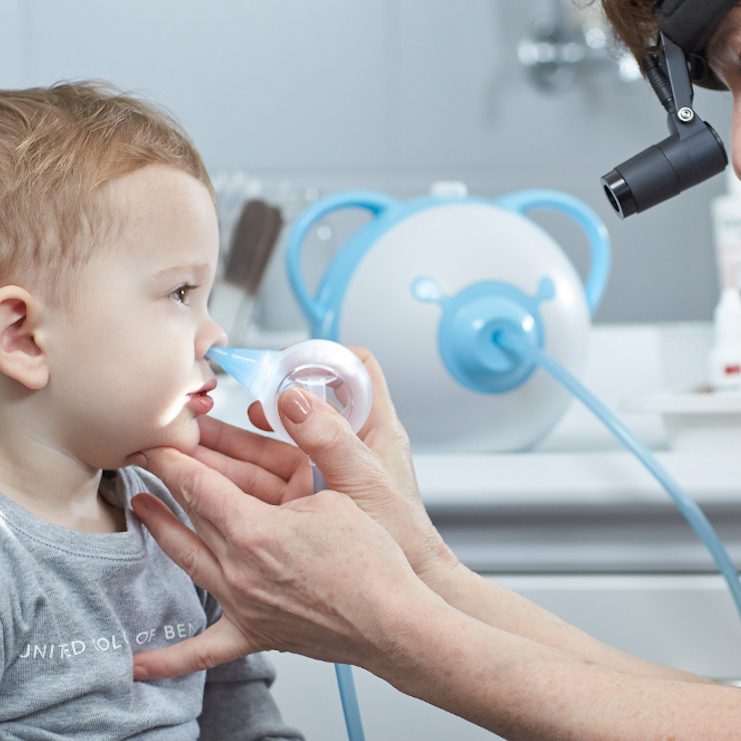
 Why to use?
Why to use?
-
Facilitating nasal breathing in infancy
-
Illnesses of the upper airway in early childhood
-
Allergy-like symptoms
Newborns breathe through their nose almost exclusively until they are several months old!
Why is it a problem?
When a baby has stuffy nose, they cannot breathe properly, so the satisfactory oxygen-supply is not secured. They don’t get enough air through their mouth so they cannot sleep soundly, suck their dummy or suckle. A stuffy nose in a baby is a struggle during night – when you child doesn’t sleep then neither do you.
What can you do?
As parents, it is our responsibility to secure nasal breathing because a baby with stuffy nose cannot blow their nose. By aspirating the nose with the help of a nasal aspirator, we free the airways and provide for the conditions of a peaceful rest and nourishment.
Newborns can only breathe through their noses till the age of 6 months. They cannot breathe properly with a clogged nose so the satisfactory oxygen-supply is not secured.
They don’t get enough air through their mouth so they cannot sleep soundly, suck their dummy or suckle.
As parents, it is our responsibility to secure the nasal breathing because babies cannot blow their nose.
By aspirating the nose, we free the airways and provide for the conditions of a peaceful rest and nourishment.
In early childhood, little ones catch cold 5-6 times a year. When they enter a community, one illness is followed by the other, which can also result in stuffy nose. Especially when a newborn has a cold, we need to act! Permanent oral breathing leads to a sore throat, coughing, and the catarrhal inflammation of the bronchi.
Why does this happen?
Small children cannot properly blow their nose due to anatomical reasons.
The maxillary sinus is a crescent-shaped, vertical cavity the outlet opening of which is on top of the cavity and connects to the nasal cavity. According to the laws of physics, when a baby has stuffy nose, mucus stagnates in the lower part of the cavity and cannot discharge by itself.
Result: The superinfected stagnating mucus can cause tracheitis or the inflammation of the middle ear and the maxillary sinuses.
Most children cannot blow their nose due to the enlarged adenoid (caused by teeth growth) which can lead to serious problems in breathing and the functioning of the auditory tube. The auditory tube of children is much shorter and steeper so nasal mucus can get into the middle ear without hindrance.
Result: Middle ear inflammation and conductive hearing loss can easily develop which has a negative effect on both articulation and speech development.
Why is it a problem?
During such illnesses due to the increased secretion production, secretion accumulates in the paranasal sinuses, which can get superinfected causing serious illnesses. The damage of nasal breathing influences the speaking voice, as it can turn into unpleasant nasality.
What can you do to prevent these complications?
By removing nasal mucus from the lower nasal cavities and ethmoidal cells with the help of a baby nasal aspirator, you can prevent illnesses or accelerate the healing process. With correct nasal aspiration you can avoid serious complications and medication.
In early childhood, little ones catch a cold 5-6 times a year. During such illnesses due to the increased secretion production, the secretion accumulates in the paranasal sinuses and this can be the source of numerous illnesses.
An allergic reaction can appear already in the first couple years of a baby’s life.
How can you recognize the symptoms?
The symptoms may be a runny nose or a stuffy nose, sneezing and itchy eyes, the mucous membrane of the sinuses can swell producing immense amounts of secretion.
Why is it a problem?
By blowing the nose, secretion can be removed from the upper section of the nasal cavity, but it flows back into the maxillary sinuses and due to the anatomy of these, it cannot discharge. The stagnating mucous secretion is a culture medium for bacteria and viruses and can cause acute sinusitis.
What can you do?
By the combined use of saline solutions and nasal aspiration with an electric nasal aspirator or a manual nasal aspirator, you can remove the allergenic secretions stagnating in the sinuses and flush out the nose. By doing so, you can prevent superinfections and relieve the symptoms of runny nose, sneezing and itchy eyes. Moreover, you can reduce medication and the use of medicated nasal sprays.
With the combination of saline solutions and the nasal aspirator, you can reduce medication and the use of medicated nasal sprays.
With the combination of saline solutions and the nasal aspirator, you can reduce medication and the use of medicated nasal sprays.


